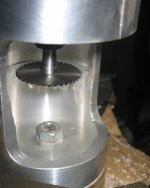Mike,
The tool that you are using does not have a releif on the sides of the cutting edges. In fact, that blade does not intend for the sides to cut at all. When you use a rotating blade to cut a rotating shaft, the blade is cutting a slot, but the slot is rotating at the same time. The result is a slot that is at an angle to the blade itself. Therefore, some of the cut must be done by the side edge of the blade. Obviously the feed rate, RPM of the shaft, and the tip speed of the blade are all factors as to how much releif the side of the blade must have. I have had much better luck with an actual slot cutter with carbide teeth. Each tooth has an edge, and a slight relief to it.
I build a new shaft called the OB-1 cue shaft. In doing so, I must turn flat laminated maple squares that are 31" long and .625" square to a final diameter of .562" before they can be assembled into my shaft blank. Turning something that long down to that small of a dowel requires cutting with no vibration at all. I use both a router in a single spindle CNC machine and also Blud's 4 spindle CNC saw lathe. Both work very well. The advantage that Blud's machine has, besides cutting 4 at a time, is that the radius of the blade being so large means that I can use a feed rate much higher and still get a smooth cut. I actually remove stock on the first pass on these squares at a feed lead of .200" per revolution. The blade moves that far for each rotation of the work piece, but there is minimal threading because of the large radius of the blade. All this is done with no vibration because the teeth on the saw blade have cutting edges on the sides with relief. On my router, I can only cut with a lead of about .07". The higher router tip speed does allow me to turn the work faster though, and that leads to higher feed speeds, but still not as fast as Blud's machine at .200" lead.
You can see some pictures of this work on my website in the construction page.
http://www.obcues.com
I still recommend using a blade that has cutting edges on the side of the blade tip. This combined with the right stock RPM and feed rates and you should not have to tend your shafts during the cut. They should come off of your machine ready for finishing.
I do use that blade that you have, but I use it for a cut off tool. I mount it in a rotary tool hand piece, and mount it on my lathe with the blade perpendicular to the work piece. I can cut off ring material very thin with it.
Royce Bunnell
Owen Bunnell Inc.
